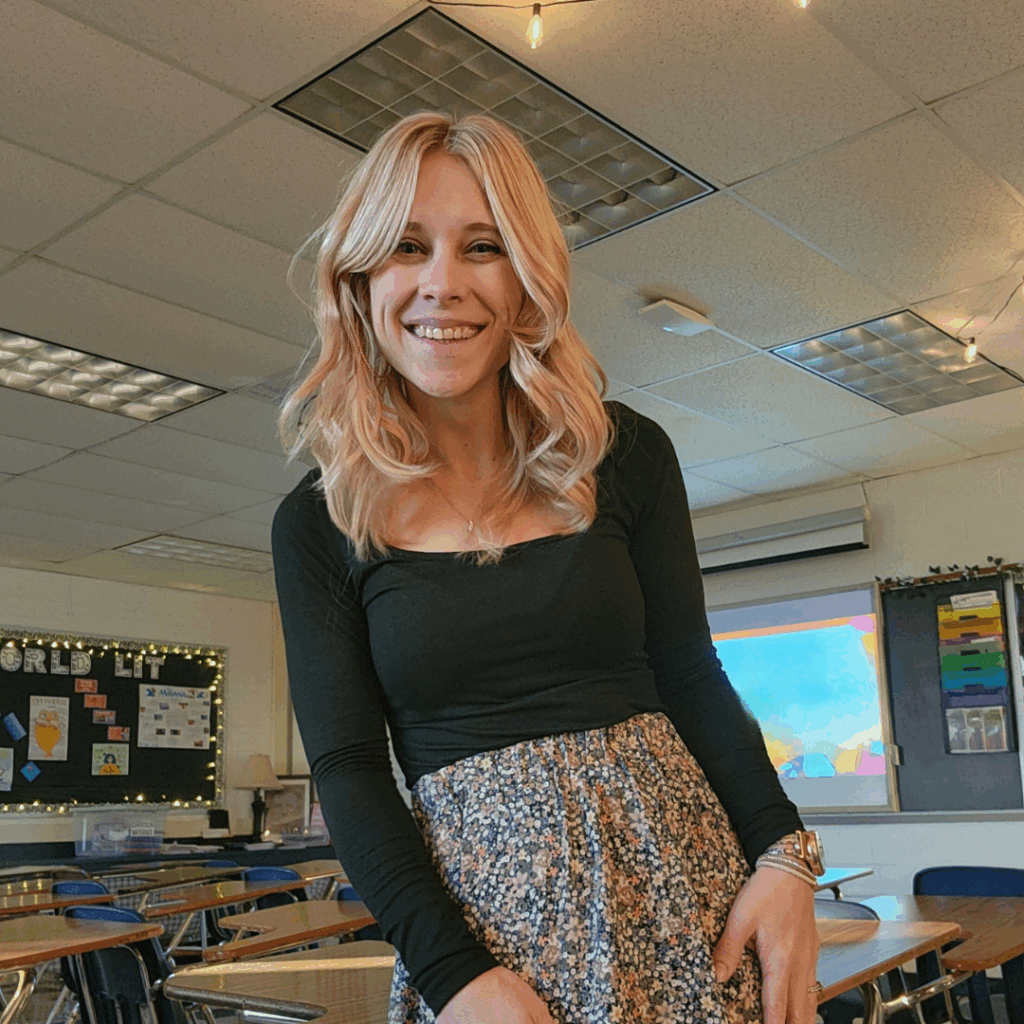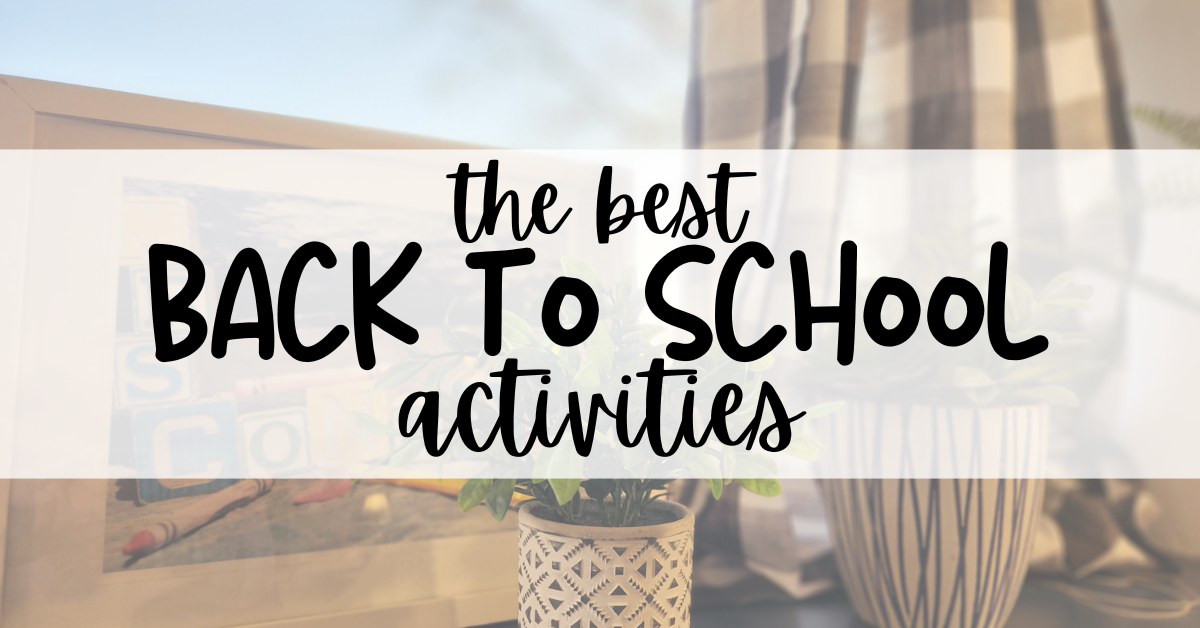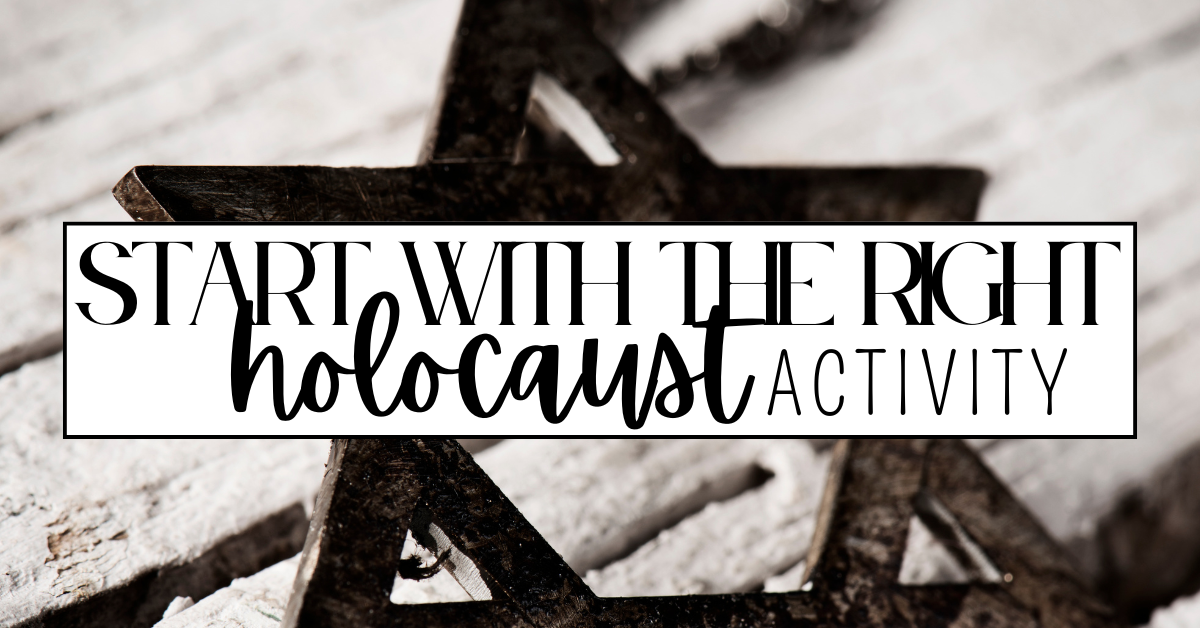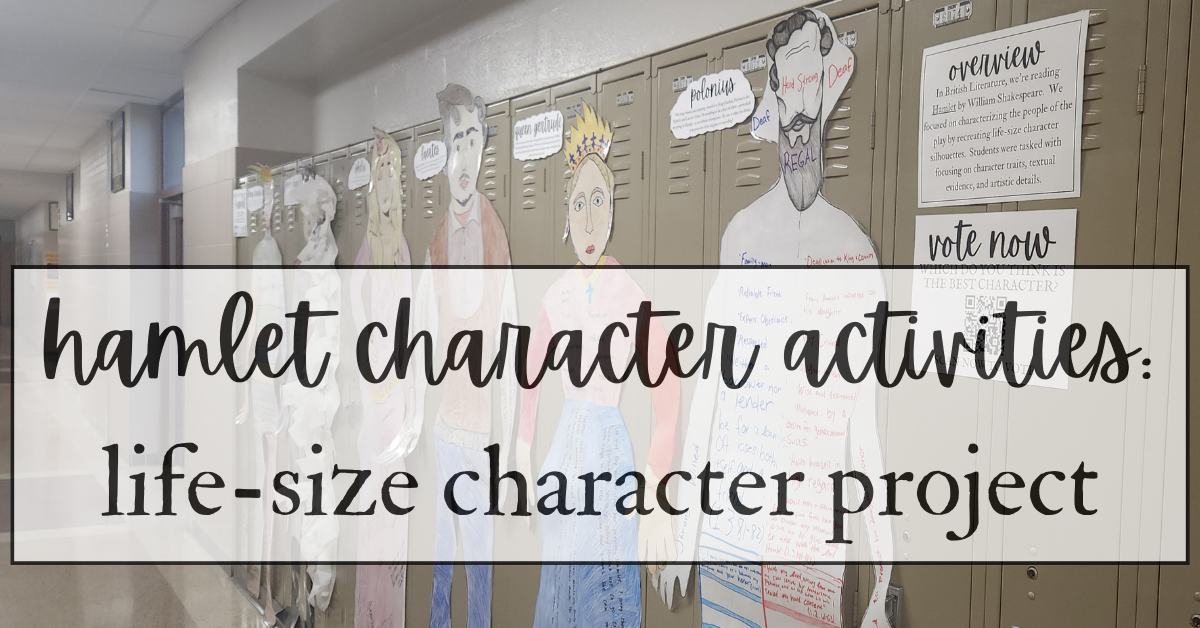I’m the kind of teacher who revamps her lesson plans every year – and aiming for the best back to school activities are no different. This summer, I sat down and really gave it some thought. What I came up with ended up being my best back to school activities yet.
My General Plan for the Best Back to School Activities
Each year I start with the same general premise. What station-type activities can I plan that will help me get to know my students, my students get to know me, and help my students better understand my classroom?
When thinking about the best back to school activities, my best advice is to avoid lecturing and syllabus reading at all costs. Unfortunately, kids are accustomed to this in so many other classes – namely at the high school level – that they won’t be able to help but tune you out.
An alternative to lecture-style plans is to have the students in the driver’s seat. Give them more control with stations, group work, partner activities, or even good old independent time.
Once I fully appreciate the learning modes I want to use for my best back to school activities, I set about planning individual tasks. Another piece of advice I can offer: don’t try to do it all in one day. In my district, our classes run on block scheduling. That gives me about 80 minutes – give or take – every other day. I remember the feeling of wanting to jump right into curricular content. But now more than ten years into teaching, I know to slow things down for my best back to school activities.
So I spread out my non-curricular lessons over the course of our first week. It’s a four day week, meaning I’ll see my classes twice each for a total of about 160 minutes. I’ll plan roughly eight to ten activities, and calculate approximately how long I want to spend on each task. Note: for the best back to school activities this first week, I always over plan. There is no way we’ll get through ten activities, but since I change it up year-to-year, I never know exactly how much time we will spend. It would be detrimental to my classroom culture – i.e. setting the tone – early in the year if we finish early and have nothing productive to do.
With a general premise for the best back to school activities in mind, I set about planning the finer details. Here’s what I came up with this year.
Day One of my Best Back to School Activities
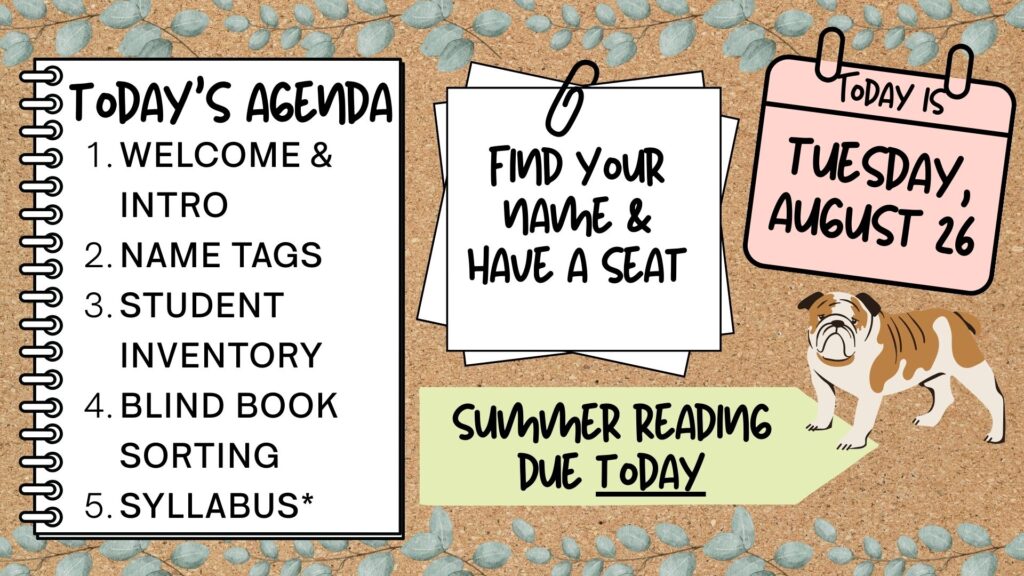
Like I said, over-planning is a must. You don’t want unproductive downtime. Even still, Day One of my best back to school activities was jam-packed with memorable and functional tasks.
Get to Know the Teacher
For years, I taught at the middle level in our district. We have two middle schools, so I taught roughly half of every graduating class. But about three or four years ago, I moved up to the high school and once again saw familiar faces. Last year’s group of sophomores was the final group of students I had in eighth grade.
This is the first year in a long time that I knew practically no students. I was nervous, to say the least. First, about learning over a hundred new names. Second, about not knowing so many of the students so well from the get-go.
Don’t get me wrong, I’m also very excited. It feels like starting with a clean slate.
But when planning this year’s best back to school activities, I thought to myself: these students don’t know me, either. So, for the first time in years and years, I built into my first day lesson plans a few slides about me.
I told students about myself and my teaching style. I told them about my family and my pets. I shared with them my favorite hobbies and what kind of music I like to listen to. And I showed them lots of pictures.
I tried to keep this portion at five minutes long, max. Remember what I preached about not lecturing the first day. I like to think it was the right amount of time, an appropriate number of photographs, and a good way to help ease some of the awkward “get to know you” stages.
Student Name Tags: One of the Best Back to School Activities
Prior to this year, I spend a good deal of my in-service time writing individual name tags for students on index cards. I’d then ask the library assistants to laminate the cards. This is how I denoted student seating the first week of school and beyond.
But this year I did something different.
One of my best back to school activities was to have students create their own name tags. It offered so much more voice and choice and saved me a ton of time.
To do so, I used Canva “bulk create” (initially intimidating but much easier than anticipated and so much fun to do!) to print a name tag template with each student’s first and last name printed very small. The first step was for students to write their preferred name or nickname largely and decoratively (if they chose) on the front of the name tag.
But we didn’t stop there.
Then, I had students customize their name tag by sketching (or explaining in writing) what their phone’s lock screen looked like. On each name tag was a little graphic of a smart phone. Each student was equipped with a box of crayons to also color the image if they wanted. I explained that students could draw their actual lock screen; maybe it was a photo of family or a significant other (cue the awkward giggles in the room at the idea of a teacher knowing student love lives exist) or maybe it was a symbol of a hobby. I emphasized that artistry was not a top priority here.
It was a great way for students to further say something about themselves on their terms.
Then we flipped the name tag over and I instructed students to simply “draw a pig.” I’ll share more details on this task further into this blog post. I did get quite a few confused looks. Depending on the student and the vibe I got, I might tell them literally: “We’re going to use this next time to psychoanalyze you.”
The final bit of the name tag design was to choose a quote from my provided list and explain why that quote means something. I displayed (first one at a time) a list of eleven quotes that I felt were pretty universal. Students were encouraged to write down any number quote they felt they liked. At the end, I displayed all eleven once more; if students heeded my advice, it was easy enough to find that quote again.
Then I had students write a few sentences about why they chose that quote. How did it speak to them? Does it describe where they are in their life currently, or does it accurately portray a goal they have for themselves? Maybe the quote sums up who the student was but they feel they have changed in some way? I left the prompts relatively open-ended so students could have a say in what they wrote. Remember: voice and choice can go such a long way in these best back to school activities.
Student Inventory: A Must-Have in your Best Back to School Activities
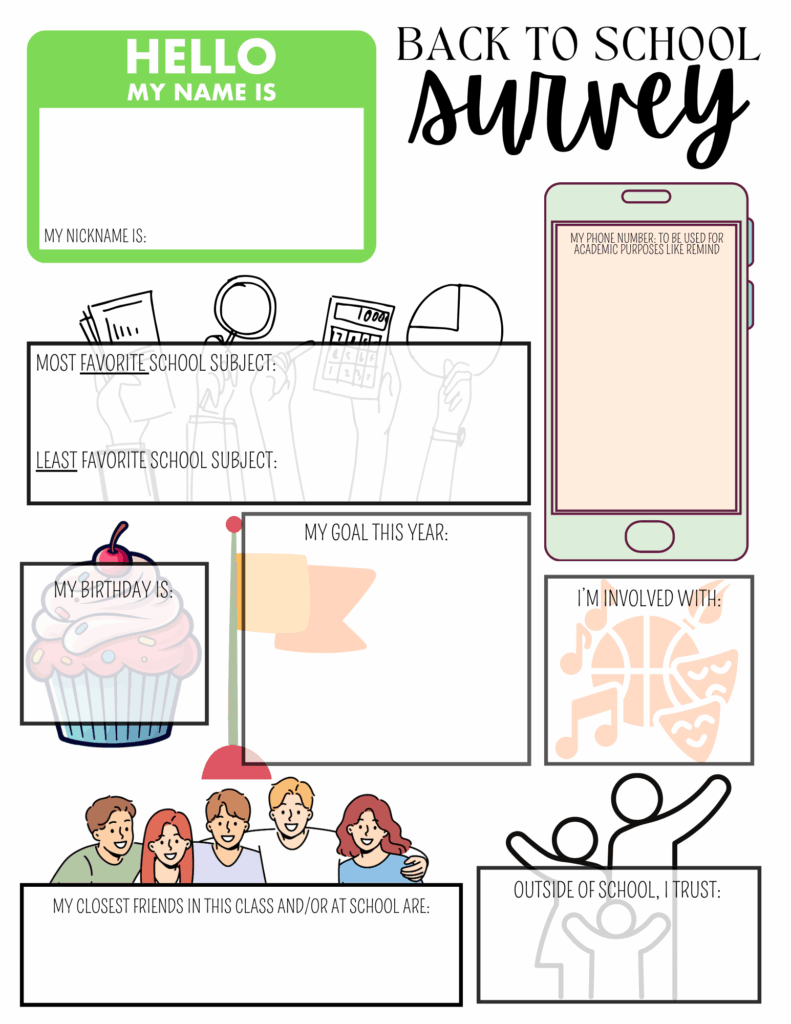
Before we get into my personal favorite of the best back to school activities, I have students take a few moments to fill out a student inventory or student survey.
Here, I ask for their name and phone number. I always set up a Remind 101 course for each class section. I promise not to spam the kids; rather, I’ll text them when we have a major assignment due or the end of the quarter approaches.
I also ask for information like their birthday and closest friends. Who do they trust outside of school? What are their favorite and least favorite school subjects? What are they involved with in and out of school?
It’s quick and it’s simple, but don’t underestimate the value of this task. Again, it offers voice and choice. And it helps me get to know my students better. It’s something I have used year after year for good reason.
I also make this available in Spanish for my ESL students.
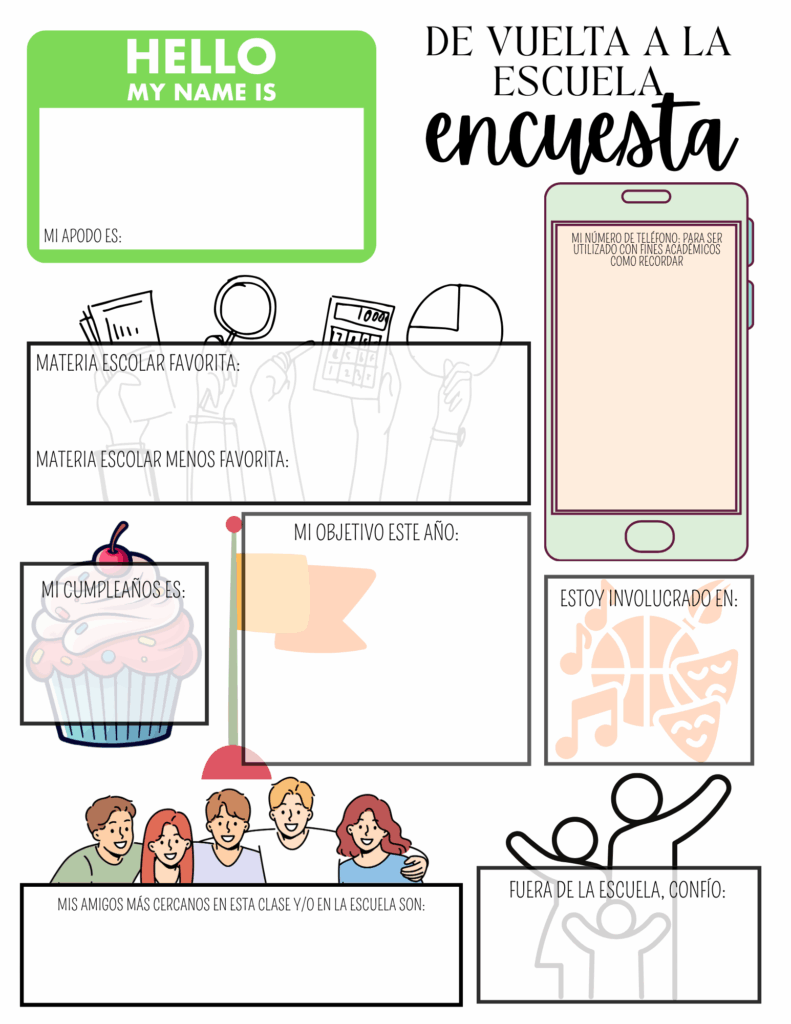
Blind Book Sort: One of the Best Back to School Activities of my Teaching Career
The most exciting of all my best back to school activities has to be this one: blind book sorting. I’ll definitely post a blog later on that details this activity more, but for now, here’s a quick synopsis of an awesome activity.
Not to belabor this point, but keep in mind my advice about keeping lecturing to a minimum. In previous years, I introduced the syllabus – and thus our course canon – on the first day, usually lecture-style.
Not this year!
This year, to introduce the texts we’ll read, I had students put themselves in self-selected groups of four to five students so they could work hands-on with the books we’ll read.
Ahead of time, I used heavy cardboard poster board from the Dollar Tree to make replica “books” of eight of our course texts. Once I cut the boards to size, I glued a book jacket of sorts to the board. On the front was the title and author, of course, with related images to help summarize the text.
On the back of the book I wrote an overview of the text, sparing revelatory details (no spoilers here!) but infusing it with rich content-specific vocabulary and clues as to the time period, location, and themes.
Each stack of eight books also came with an envelope containing the book’s genres.
The goal? Students had to work together to figure out which genre goes with which text. To make it more challenging, I also had my Advanced class figure out the time and place the text was written.
I gave students about fifteen to twenty minutes, depending on how long each of the previous tasks took, to work together. In the past, I probably would have chosen the groups – or at least had students count off by fours – but this year I wanted them to choose the groups for a few reasons.
First, doing so allowed students voice and choice. They were much more receptive to the task at hand if they felt comfortable with their group mates.
Second, I could see exactly who should and should not work together in the near future.
It was so cool to see students piece together all the clues. I loved how they called me over again and again to check their answers (even though I promised we’d go over the answers together as a class soon enough). And I loved that I could productively wander around the groups and have brief but meaningful conversations with my students on this very first day.
In an effort to keep students busy, I also over-planned here: I gave each group a handout that had them record their answers and defend their choices. Once it became abundantly clear to me that students were having meaningful conversations and would run out of time to write their responses, I made a class-wide announcement that they didn’t need to worry about recording their answers if they ran out of time. You know how some students are: they get very anxious about not doing everything the teacher prescribes. My announcement seemed to alleviate those concerns.
With about ten minutes left in class, I had students return to their seats and we went over the answers together. I built in slides in my presentation for this purpose. At this time, I covered the title, author, genre, and setting details while also tapping into my inner sales woman. I included details from past years – i.e., “This is always one of students’ favorite units” – and zingers like “And for this unit, we’re going to Hell” (it’s my Dante’s Inferno unit) to grab students’ attention.
I’m mindful to keep my lecturing to a minimum, even here. And before I knew it, Day One of my best back to school activities was complete!
Day Two of my Best Back to School Activities
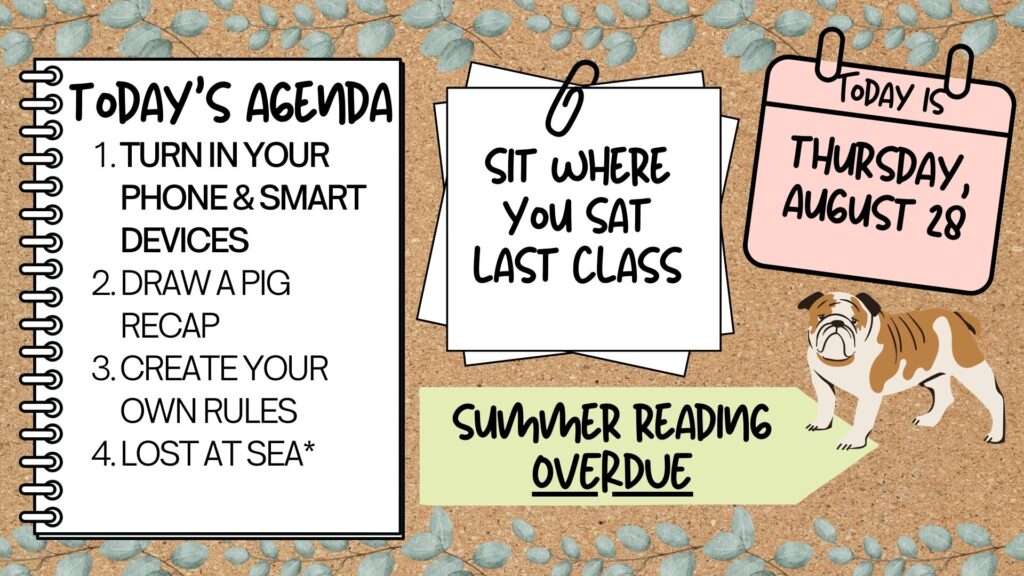
One of the best back to school activities I ran out of time for on the first day was a brain break of sorts. It’s called “Lost at Sea.” For this task, students work in a group – or it could be done independently – to prioritize which items are most vital should you ever be stranded. Though I ran out of time for it on the first – and second – day, I did plan for this to be a brain break the second week of school when we’re still covering non-curricular items but starting to get into content.
Student Folders
Though I used students’ name tags to help me learn names, another simple task to get to know names is to hand out folders this second day.
One of the best back to school activities isn’t glitzy, but it’s functional: distributing a folder to each student.
Each year, I provide my students with a two-pocket folder; I build this cost into my budget annually. On the cover is a label with the student’s first and last name and the course title (i.e. World Literature, “Advanced World Literature,” “British Literature”). On the inside this year, I’m trying something new. I also printed labels that say “Keep (Old Units)” and “Current Unit.” My hope is this will help my students – primarily my sophomores – find a simple yet effective organizational system for keeping or discarding course paperwork.
Draw the Pig: Recap
Remember one of the best back to school activities on the first day included drawing a pig on their name tags? Today, we recap what that means.
Over the summer, I found this scientifically non-proven but fun idea: how you draw a pig can reflect certain aspects of your personality. Again, this is non-proven from a scientific standpoint, and I make that quite clear to my students from the start. I don’t want anyone offended this second day.
I have students look again at their pig. Then I take them through a brief set of slides in my presentation that cover what different aspects might mean. For example, if you drew your pig towards the top of the paper, you are most likely an optimistic person. Or, if you drew a pig with a lot of details, you might be an analytical person. The larger the ears on your pig, the better listener you are. And the larger your pig’s tail, the smarter you might be.
Once I’ve done my spiel, I direct students to an independent writing activity. I want them to reflect on what they learned, or, for those who may have found the activity total baloney, I want them to tell me about themselves. Here, I set the timer for ten minutes and direct students to fill that time productively and quietly.
Like most of my best back to school activities, this one serves more than one purpose. This independent time allows me to see who works well under such circumstances and who might be a little antsy. It also allows me to get to know my students further from their perspective. I don’t grade this task, but I do read every response to see what students think about themselves.
The reflection also allows me to get a preliminary understanding of students’ writing ability. And, as it always seems to be the case at least once, I can have a documented example of student handwriting should the need arise (i.e. in scenarios involving cheating).
Course Syllabus: A Necessary “Evil” for the Best Back to School Activities
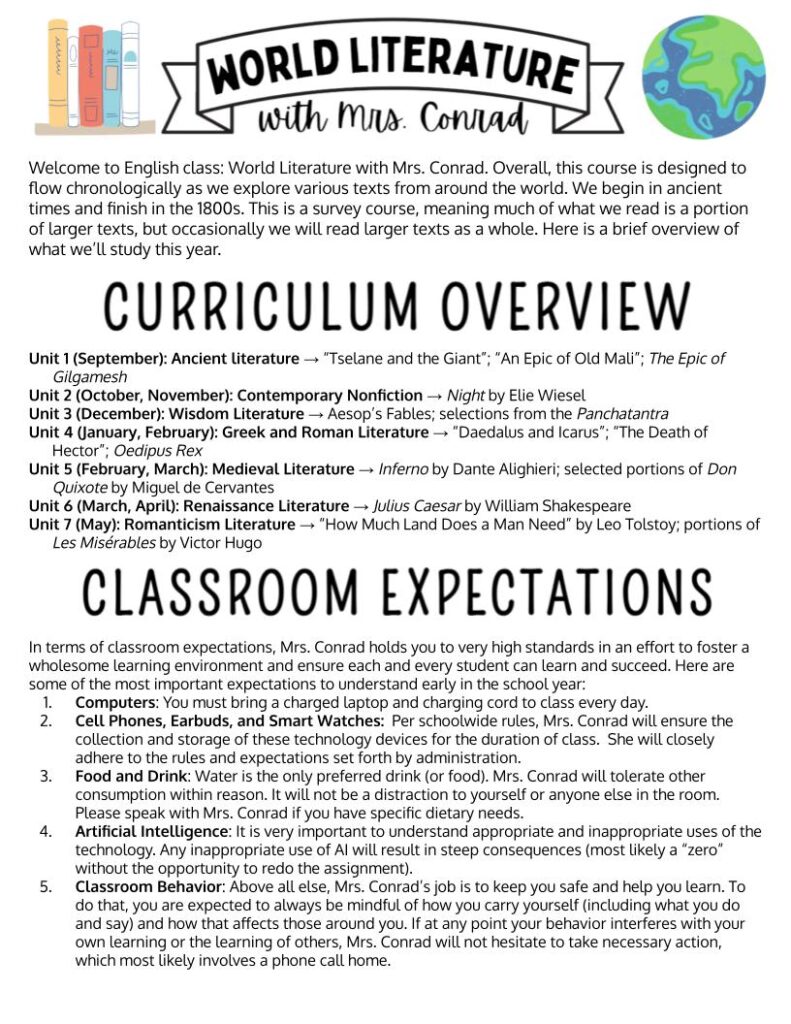
In my head, I hear Rafiki from The Lion King say, “It is time” when I think back to my syllabus introduction. I want to try and avoid lecturing as much as possible, but I do think there is value to its inclusion if used wisely and consciously.
That’s how I feel about the syllabus. Sometimes you just have to deliver the information in a straightforward manner. Do I expect my students to remember every single detail? Absolutely not. But I do want to set the precedent and the tone early on.
So we tackle the syllabus.
A lot of it we can cruise over. For example, I include a section of course canon in the syllabus. Thanks to the Blind Book Sorting, we can skip over that.
We do hit hard some of the nit-picky details like grading policies and submitting late work. I take students on a little “tour” of Schoology to show them some valuable information.
This bit probably takes about 15-20 minutes. In the past I’ve also included a Kahoot to “test” what kids know. This year, given all else I planned with my best back to school activities, I knew we wouldn’t have time.
Socratic Seminar: A Daunting Idea for the Best Back to School Activities
Keep in mind some of my goals with this year’s best back to school activities, namely voice and choice and group work.
Part of my syllabus I somewhat glaze over are the course expectations. In general, there are five big ones:
- Bring a charged computer to class each day
- No food or drink other than water in this classroom
- No cell phones, earbuds, or smart watches (this is a miraculous school-wide policy in my district, but I’ve been implementing it longer than that)
- Understand the AI policy (more to come on that later)
- Behavioral expectations
To speak more on the behavioral expectations: here I spend a greater deal of time than the other expectations for various reasons. One of those reasons: this is arguably the most important of the classroom expectations. I make it very clear to students that I aim to have fun but at the end of the day, I have two jobs: to keep you safe and to ensure you can be successful in your learning. If student behavior ever compromises either of those jobs, then I have to step in. Whether a student hinders his or her own learning or the learning of others will dictate the measures I take.
This year, I wanted to try two things: offer more voice and choice when it comes to expectations and see how students can handle a Socratic seminar-type discussion.
Looking back on previous years, I’m often regretful that I didn’t try a Socratic seminar sooner. It’s usually because I’m too scared (full disclosure) of releasing so much control with sophomores. So I usually try the first with my Advanced classes and not until January. When we finish, they usually provide feedback like, “Can we do more” and I think to myself, “Why didn’t we try this sooner?”
So for this year’s best back to school activities, I decided to give it a go.
Once again, I allowed students to choose their groups. Each group was tasked with reviewing the core expectations with the goal of evaluating them. Which do you agree or disagree with? Are there any that are confusing or that should be worded more clearly? What expectations are missing entirely and should we add for our course?
I knew this was a tall order, so I provided each group with a “think sheet.” It reminded them of the core expectations but also explicitly stated those questions (and more) that could help them get started.
On the board, I set a timer for about ten to fifteen minutes. I bounced around the room, sometimes just listening to conversations and more often than not, interjecting some guiding questions to help the group refocus or dig deeper.
The “think sheet” had a total of about eight or nine questions, so most groups, I knew, wouldn’t have time to answer all. I assured groups – much like the day before – that they didn’t have to get to all the questions; they could pick and choose which were more interesting to them. If they ran out of time to write down all answers because their conversations were that in-depth, that was a sign of a good discussion. I told them I trusted their judgment, which I like to think goes a long way these early days.
When the timer expired, we came together again as a large group. For some classes, I directed them back to their assigned seats. Others were allowed to remain with their groups. Honestly, it depended on how productive each class seemed to be.
Most students have never engaged in a Socratic seminar, so I laid some ground rules, namely that the goal is for the teacher to take a total back seat. Students could choose who would speak without raising their hand and waiting to be called on. I modeled some phrases like:
- To agree: “I really like what ___________ had to say about __________, and here’s what I would like to add…”
- To respectfully disagree: “While I can see where ________ is coming from, I look at it this way…”
- To naturally change the topic when the conversation has stalled: “It seems like we’ve said all we need to about _______; I’d like to next talk about ______…”
Reader, I thought there was no way this could fail. Kids love to talk, right? I have small class sizes, right? I was directing students to talk about what interested them, right?
I won’t say it failed. It wasn’t like students went off the deep end and chaos ensued.
No, it was more like complete silence. Just me staring at them. Them staring at me. Eventually, I could get some of the kids to open up. But it was really a struggle. As a teacher, I hate to call on kids randomly; it just isn’t my style, even though I do know of its benefits. In some classes (again, I read the room), I did try that approach, but it wasn’t much more successful than not calling on them randomly.
So, would I consider this one of the best back to school activities? I would still say, “Yes.” I think there was value in having students work in groups. The conversations I heard were largely productive and interesting. The activity offered voice and choice. And it exposed students to a discussion technique I hope to use much more often this year. But when reflecting on this next year, I’ll give more thought to how I can get more students to open up when we come together.
Not Enough Time for the Best Back to School Activities
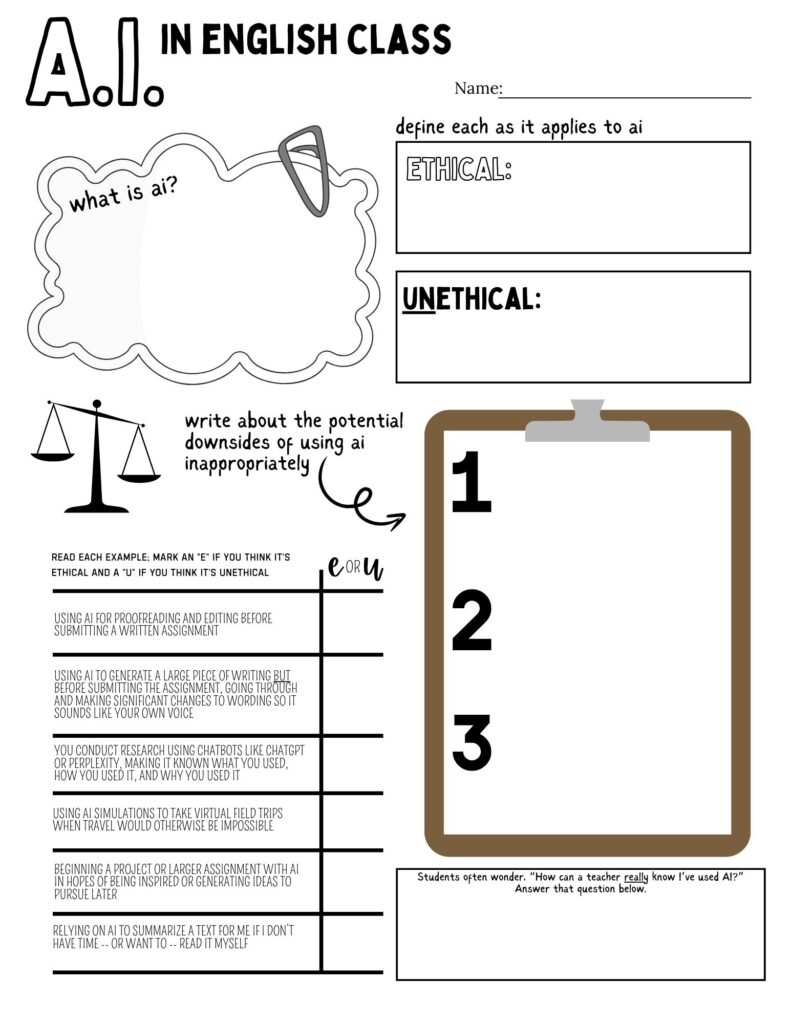
Over-planning. I would still do this for my best back to school activities knowing I ran out of time. Primarily, I ran out of time to cover my artificial intelligence policy. A blog post about that is coming soon; it’ll also come with a soon-to-be–published Teachers Pay Teachers product.
I can’t very well exclude this crucial policy just because we ran out of time. So we pushed it back to the following week. Originally, I had hoped to jump right into curricular content with some introductory topics here and there.
Instead, we started the next class with the AI Policy and built in a Brain Break (remember “Lost at Sea”?) before beginning Unit One.
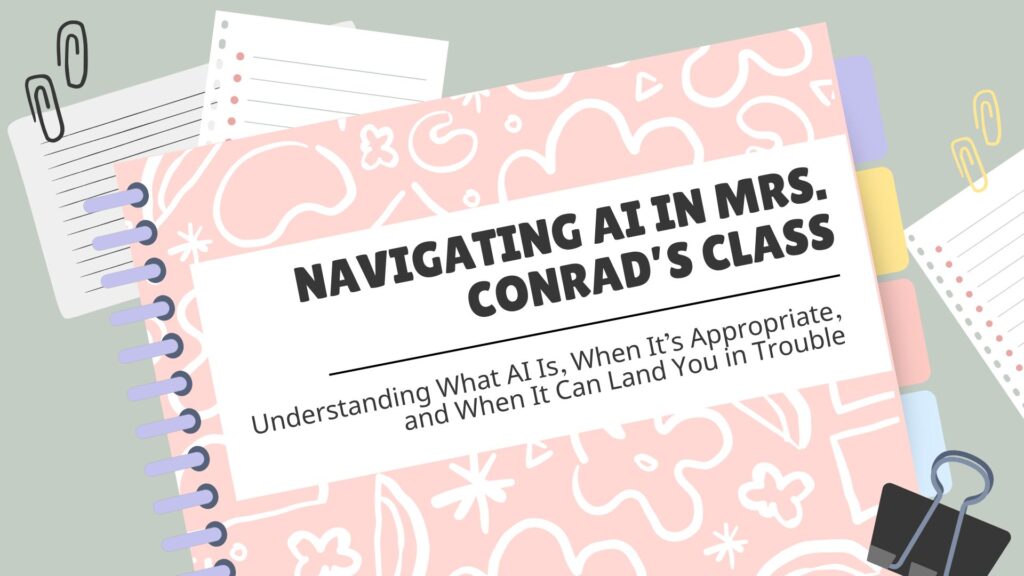
Concluding Thoughts on the Best Back to School Activities
All in all, these were the best back to school activities I have done in years. They hit the mark in so many of the goals I set for myself:
- Keep lecturing at a minimum
- Offer more voice and choice
- Allow students to work in self-selected groups
- Cover key information about the course
If you liked the ideas in this article, be sure to check out some of my other best back to school activities on my Teachers Pay Teachers page. CLICK HERE. If you have time, check out some of the best sellers, too.
What are some of your best back to school activities?
